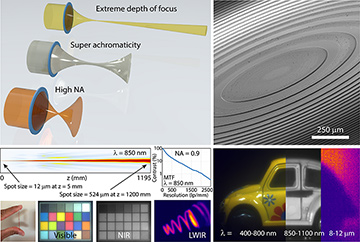 Top left: Multi-level diffractive lenses (MDLs) can achieve extreme depth of focus, large operating bandwidths and high numerical apertures. Top right: Scanning electron micrograph of an exemplary MDL. Middle row: Experimental demonstration of extreme depth of focus (left) and MTF of high-NA MDL (right). Bottom row: Photograph of MDL images in the visible (strehl ratio = 0.8), near-infrared (NIR) and longwave infrared (LWIR) bands. Rightmost panel shows composite visible-NIR-LWIR image with a single MDL and multiple sensors. [Enlarge figure]
Top left: Multi-level diffractive lenses (MDLs) can achieve extreme depth of focus, large operating bandwidths and high numerical apertures. Top right: Scanning electron micrograph of an exemplary MDL. Middle row: Experimental demonstration of extreme depth of focus (left) and MTF of high-NA MDL (right). Bottom row: Photograph of MDL images in the visible (strehl ratio = 0.8), near-infrared (NIR) and longwave infrared (LWIR) bands. Rightmost panel shows composite visible-NIR-LWIR image with a single MDL and multiple sensors. [Enlarge figure]
A lens is the most fundamental and essential element in any imaging system. However, traditional refractive lenses are bulky owing to their curvature. Flat diffractive lenses can overcome this difficulty, but traditional diffractive optics have limited reach, primarily due to chromaticity.
Recently, we have shown that by treating the “imaging” phenomenon as simply information transfer from the object to the image plane, the spatial distribution of the phase in the focal plane can be an arbitrary function. (Here we refer to the phase of a scalar electromagnetic field, but the argument is equally valid for vector fields.) This is true because, in the vast majority of imaging applications, only the intensity, as recorded by the image sensor, is of primary interest for producing an image.
Using this concept, we have shown that allowing the phase in the image plane of a flat lens to be a free parameter enables imaging properties of unprecedented versatility in flat, multilevel diffractive lenses (MDLs) through careful design of different diffractive surfaces.1 The properties we have shown in such flat lenses include super-achromaticity,2,3 extreme depth-of-focus (EDOF)4 and high numerical aperture.5 In each case, the design principle and method remain the same, the only change being in the formulation of the figure of merit of the design optimization for the desired MDL property. These flat lenses can be easily fabricated using one-step grayscale lithography.
We have demonstrated an MDL that achieves an extreme depth of focus by more than four orders of magnitude.4 Using this flat lens, we were able to maintain focus for objects that are separated by as large a distance as roughly 6 m in our experiments. When illuminated by collimated light at λ = 0.85 µm, the MDL produced a beam that remained in focus from 5 mm to 1200 mm. We have also demonstrated super-achromatic MDLs operating in the LWIR (8–12 μm), visible to NIR (0.45–1 μm), visible to LWIR (0.45–15 µm) and even the far IR (1.5–150 μm). Finally, we successfully demonstrated an MDL with thickness less than
1.35 µm, a diameter of 4.13 mm and NA = 0.9 at an operating wavelength of 850 nm (bandwidth approximately 35 nm).5
We believe that our inverse-designed flat MDLs, which can be manufactured using low-cost imprinting techniques, could prove widely applicable—especially where weight and restricted form factor are important considerations, as in aerospace and airborne imaging as well as augmented and virtual reality displays.
Researchers
Apratim Majumder, Monjurul Meem, Sourangsu Banerji and Berardi Sensale-Rodriguez, University of Utah, Salt Lake City, UT, USA
Rajesh Menon, University of Utah, Salt Lake City, UT, and Oblate Optics, Inc., San Diego, CA, USA
References
1. S. Banerji et al. Optica 6, 805 (2019).
2. M. Meem et al. Proc. Natl. Acad. Sci. U.S.A. 116, 21375 (2019).
3. M. Meem et al. Appl. Phys. Lett. 117, 041101 (2020).
4. S. Banerji et al. Optica 7, 214 (2020).
5. M. Meem et al. Optica 7, 252 (2020).

